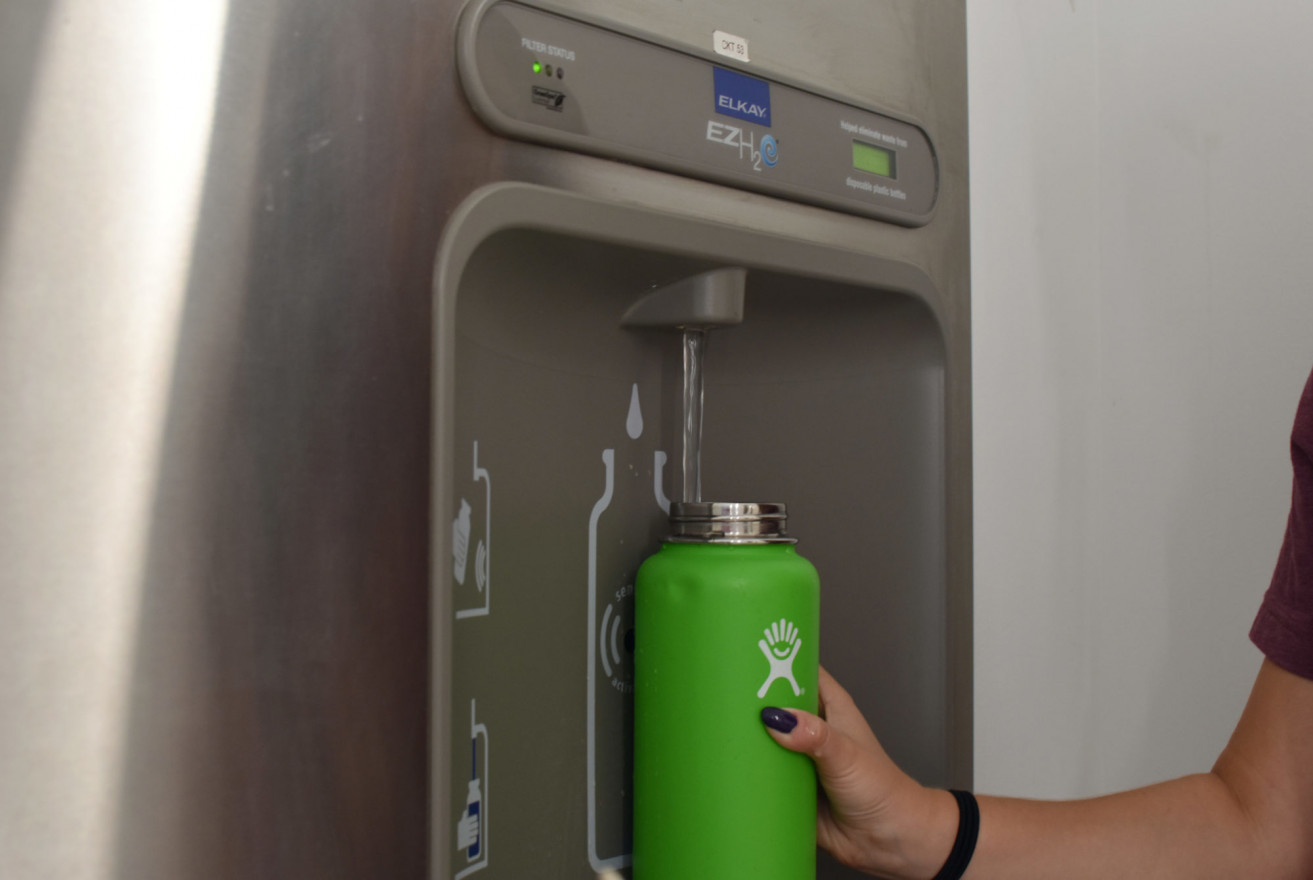
One of the bottle refilling stations on campus. (Alexander Welling/The Hatchet)

One of the bottle refilling stations on campus. (Alexander Welling/The Hatchet)
A task force aiming to eliminate the use of single-use plastics on campus produced a report in October 2020 recommending plans like cutting plastic bottles from vending machines and installing more water bottle fillers in residence halls.
University spokesperson Crystal Nosal said the task force, which convened in September, received administrative support and is now working on a plan to implement the proposals. Nosal said Executive Vice President and Chief Financial Officer Mark Diaz organized the group, which consists of officials from six departments, including offices within the Division of Safety and Facilities and the Office of Procurement.
The Student Association Senate passed a resolution in late October calling on officials to discontinue using single-use plastic bottles on campus. Nosal said the task force’s goals align with the SA’s resolution.
Scott Burnotes, the vice president of safety and facilities, said officials have approved the plan, and the Division of Safety and Facilities will now work on finding ways to implement the recommendations. He said officials will start to implement the plan in the “next several months” and are excited about the “shared commitment” to a zero-waste environment.
“GW’s commitment to phasing out single-use plastics will be a marathon, not a sprint, especially given the hurdles higher ed is already dealing with this year,” he said in an email.
Kat Ruane – the co-president of Take Back the Tap, a student organization that works to reduce GW’s use of single-use plastics – said the task force meets at least once every two weeks. She said the task force’s members hope to organize educational initiatives with student organizations to discuss the harmful environmental effects of single-use plastics.
“We’re thinking from the human rights perspective that all students deserve a right to accessible clean water, not one that’s put behind a paywall of a plastic water bottle,” Ruane said.
Ruane said the draft plan includes proposals to eliminate all plastic bottles from vending machines, install reusable water fillers in residence halls and develop strategies to discourage community members from using non-reusable plastics.
She said officials have not yet offered the task force clear details on the next steps for the plan submitted to Diaz, the chief financial officer, at the end of October.
“It is a bit frustrating because there is to some degree lack of transparency and lack of communication about what they’re actually going to do next from here because they’ve submitted their draft plan to Mark Diaz,” she said.
Experts in sustainability said implementing programs that discourage people from using plastics has been the most effective method in reducing non-reusable plastics.
Lyda Harris, a University of Washington Ph.D. candidate studying microplastic contamination, said she has seen “limited success” in educational initiatives encouraging people to reduce their plastic use because people typically weigh convenience over sustainability when making purchases. She said implementing measures that make reducing plastic use easier, like installing water bottle filler stations, are more effective methods.
“If you give someone all the knowledge that they need, I personally think that it comes down to which one’s easier and which one do I have time for,” she said.
Harris said the best way to reduce plastic consumption is to implement a system, like a small charge on plastic bags, that makes plastic products inconvenient to obtain. D.C. officials implemented a mandatory plastic bag tax in 2010.
“In Europe, there is a really cool study that has been done about plastic bag taxes and bans,” she said. “And it basically said once you assign a 5-cent tax on a plastic bag, people stop using them up to like 96 percent. And so it just makes it harder to pollute the environment.”
Evan Ward, a professor of marine sciences at the University of Connecticut, said non-reusable plastics can be incinerated, which increases the amount of greenhouse gases in the atmosphere, or buried, which can leak chemicals into groundwater over time.
“Burying plastics is not that problematic, but over time, large amounts of plastic can leach a variety of chemicals, which can enter groundwater and contaminate drinking water, lakes, streams and near-shore environments,” he said in an email. “Recycling is an option, but unfortunately only about 9 percent of all plastics are recycled.”
He said universities could take steps, like removing plastic water bottles carrying the institution’s logo, to draw people away from using single-use plastics.
“Same goes for single-use plastic bags in the bookstore and elsewhere,” he said. “Charge a small fee for selecting plastic bags over reusable bags – you will see how quickly everyone will remember to bring a reusable bag with them.”
—
This piece was originally published by The GW Hatchet. The photograph is attributed to Alexander Welling, Senior Staff Photographer at The Hatchet.